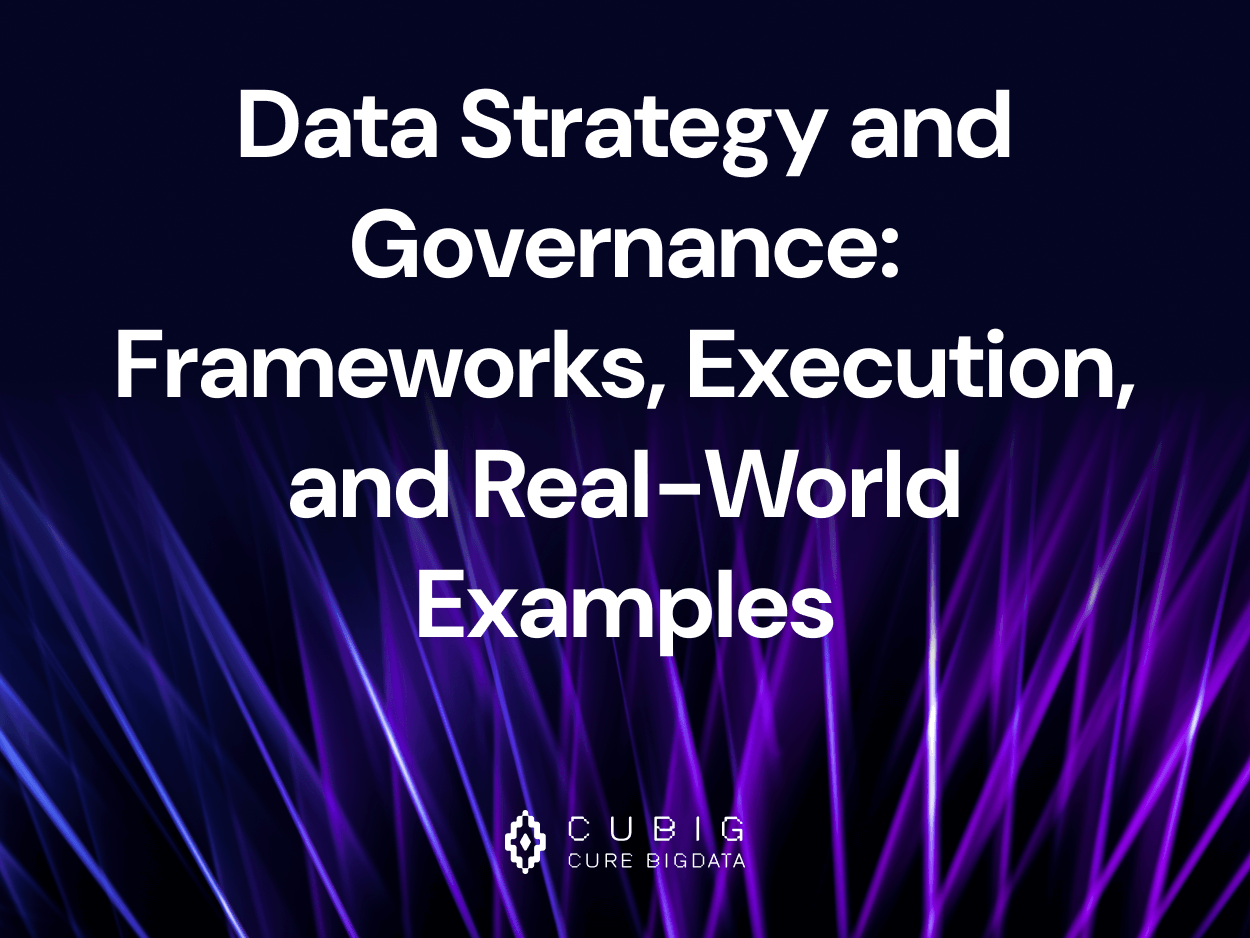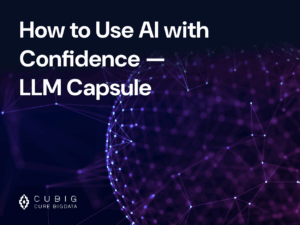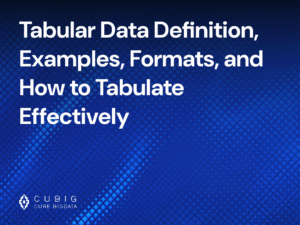Data Strategy and Governance: Frameworks, Execution, and Real-World Examples
Table of Contents
What Is Data Strategy and Governance?
Definitions and Differences Between Data Strategy and Governance
Data strategy is a comprehensive, high-level plan that outlines how an organization will use data to achieve its overall business objectives. It includes vision-setting, roadmap creation, investment planning, and alignment with digital transformation goals. A well-defined data strategy ensures that data is treated as a strategic asset, enabling better decision-making, customer personalization, operational efficiency, and innovation. In contrast, data governance focuses on the operational and regulatory aspects of data management. It defines the rules, standards, policies, and procedures to ensure data quality, integrity, privacy, and compliance across the data lifecycle. While data strategy answers the question of “what” and “why,” data governance addresses “how” and “who.” Strategy sets the direction and goals; governance ensures consistency, security, and accountability in execution.
Why Both Are Critical for Enterprise Data Success
Organizations cannot succeed with data alone—both vision and control are required. A data strategy provides the blueprint for how data can deliver value, whether through new digital services, AI/ML capabilities, or customer insights. Without it, data efforts often become fragmented or misaligned with business needs. On the other hand, without governance, organizations risk working with poor-quality data, violating privacy regulations, or creating data silos. For example, a company pursuing AI-driven automation without governance may end up using biased or outdated datasets, undermining results. When combined, strategy and governance create a reliable, scalable, and secure data foundation that supports sustainable growth, regulatory compliance, and cross-functional collaboration.
Core Components of a Data Strategy
Vision and Business Alignment
Every effective data strategy begins with a clearly defined vision that connects data initiatives directly to business priorities—whether that’s improving customer satisfaction, accelerating product development, or increasing operational efficiency. This vision should be developed in collaboration with executive leadership and department heads to ensure alignment across the organization. Key performance indicators (KPIs) should be established to measure success, and data priorities should be evaluated continuously to adapt to shifting market or internal conditions. Without business alignment, data efforts risk becoming siloed or underfunded.
Data Architecture and Infrastructure Planning
This component focuses on the technical backbone that enables secure, scalable, and efficient data operations. It includes designing how data flows across systems, where it is stored (e.g., data warehouses, lakes, or lakehouses), how it is accessed (e.g., APIs, data catalogs), and how it is processed (e.g., real-time vs. batch). Architecture planning must also evaluate cloud versus on-premise trade-offs, especially in terms of cost, performance, latency, and regulatory constraints. Scalability, redundancy, and integration with existing enterprise systems are also key considerations. A robust architecture ensures that data is accessible, trustworthy, and ready for analytics or AI.
Analytics, AI Readiness, and Use Case Prioritization
To realize value from data, organizations must identify and prioritize high-impact use cases—such as predictive maintenance, customer segmentation, fraud detection, or supply chain optimization. This involves assessing whether existing data is clean, complete, and structured appropriately for AI/ML or advanced analytics. Data maturity assessments can reveal gaps in data collection, labeling, or accessibility. By aligning use cases with business goals and readiness levels, companies can focus resources where they will generate measurable ROI. This approach also avoids “AI hype” by ensuring that technical initiatives are grounded in real business needs.
People, Process, and Technology Alignment
Data strategy isn’t just about systems—it’s about people and how they work together. A successful strategy defines roles and responsibilities across data engineering, data science, IT, compliance, and business teams. This includes establishing data ownership, stewardship, and governance councils. It also involves standardizing processes such as data onboarding, access control, and quality assurance. Technology decisions should support—not hinder—collaboration, with tools for pipeline orchestration, metadata management, and cross-team communication. Ultimately, aligning people, process, and technology enables a culture of data-driven decision-making and operational excellence.
Key Elements of a Data Governance Framework
Policy and Standards Definition
A strong data governance framework begins with clearly defined and well-documented policies that serve as the foundation for consistent data practices across the organization. These include naming conventions, data classification rules, access permissions, retention schedules, and usage guidelines. Policies should be designed to scale with the organization’s growth and adaptable to new regulations or technologies. Importantly, they must also be enforceable—supported by automated controls and embedded in day-to-day workflows. Without standardized policies, inconsistencies across departments can lead to data silos, reduced trust, and increased compliance risk.
Data Stewardship and Accountability Roles
Governance frameworks require clearly defined roles to ensure accountability and oversight. Data stewards are responsible for maintaining the quality, integrity, and availability of specific datasets. They act as the bridge between technical teams and business users, ensuring that data remains fit for purpose. In parallel, data governance councils or committees provide strategic oversight, resolve cross-departmental conflicts, and monitor policy compliance. Defining ownership is essential—not only for data management but also for assigning responsibility during audits, incident responses, or data lifecycle transitions.
Metadata Management and Data Quality
Metadata—often described as “data about data”—provides critical context such as data definitions, source lineage, transformation logic, and update history. Proper metadata management enables users to understand where data comes from, how it’s changed, and how reliable it is. Governance teams must ensure metadata is accurate, standardized, and accessible via catalogs or discovery tools. This supports traceability, reduces duplication, and enhances user confidence. Additionally, data quality programs should define metrics such as completeness, consistency, timeliness, and accuracy—and include automated monitoring to catch and correct errors before they propagate.
Compliance, Privacy, and Risk Control
With increasing regulatory demands, governance must embed compliance and privacy controls into daily data operations. Frameworks should account for laws like GDPR, HIPAA, CCPA, and industry-specific standards. This includes data subject rights (e.g., access or deletion), consent management, and cross-border data transfer rules. Effective governance enforces least privilege access, logs data activities, and automates policy checks through tools like DLP (Data Loss Prevention) or IAM (Identity and Access Management). Risk control mechanisms should also include data classification models, breach response plans, and regular audits to proactively identify vulnerabilities or non-compliance.
How to Build a Unified Data Strategy and Governance Plan
Step 1: Assess Current Data Landscape
Start by conducting a comprehensive audit of existing data systems, repositories, and workflows. Map out where data resides (cloud, on-prem, third-party), how it’s structured, and who uses it. Identify data silos, inconsistent formats, or redundant sources that hinder collaboration and decision-making. Assess data quality issues and gather feedback from stakeholders across departments. This diagnostic phase creates a realistic baseline, highlighting strengths, gaps, and areas requiring urgent attention.
Step 2: Define Objectives and Compliance Requirements
Set clear, measurable objectives aligned with business priorities. Examples may include improving customer analytics, reducing reporting errors, or enabling faster AI deployment. Next, identify regulatory requirements based on geography, industry, or customer base. These might include retention limits, encryption standards, or consent protocols. Aligning data strategy with compliance needs ensures that data initiatives are both valuable and defensible. It also sets the stage for policies, architecture, and tooling that support both innovation and risk mitigation.
Step 3: Assign Roles and Build Governance Teams
Governance success relies on clear roles and accountability. Define specific functions such as data owners (responsible for business value), data stewards (responsible for operational integrity), and custodians (handling technical access and storage). Form cross-functional governance teams that include IT, legal, compliance, and business stakeholders. Establish escalation paths for policy disputes, create communication channels, and schedule recurring reviews. This collaborative model promotes shared responsibility and prevents bottlenecks, ensuring governance is embedded into everyday operations rather than seen as a top-down directive.
Step 4: Implement Tools and Monitor KPIs
Select technology platforms that support your governance goals—such as metadata catalogs, lineage tracking tools, master data management (MDM), and data quality dashboards. Use these tools to enforce standards, automate controls, and provide transparency. Define key performance indicators (KPIs) to measure progress, such as data accuracy rates, number of policy exceptions, or user adoption of governed assets. Monitor these metrics regularly and iterate the strategy as needed. A feedback loop between governance implementation and performance measurement ensures the framework remains effective and evolves with the business.
Data Governance Examples in Action
Customer Data Accuracy Across Departments
In many organizations, customer data is collected and used by multiple departments—marketing uses it for targeting, sales for engagement tracking, and customer support for issue resolution. Without governance, inconsistencies emerge: a customer’s contact details might be updated in one CRM but not another, or their communication preferences could be ignored. A unified data governance policy ensures that all departments access the same, validated records. This includes enforcing master data rules, synchronizing updates across platforms, and appointing data stewards responsible for customer data integrity. The result is a consistent, trusted customer experience and reduced data friction across systems.
Regulatory Compliance in Healthcare Data
In the healthcare sector, the protection of Protected Health Information (PHI) is not only a best practice—it’s a legal requirement. Hospitals, clinics, and insurers must comply with regulations like HIPAA, which mandate strict governance over who can access, modify, or share medical records. Implementing role-based access controls ensures that only authorized personnel (e.g., doctors, nurses, billing staff) can view relevant patient data. Audit trails log every access or change to records, enabling compliance teams to detect policy violations or breaches. Encryption of data at rest and in transit adds an additional layer of security. Governance in this context reduces legal risk, supports patient trust, and protects organizations from costly fines or litigation.
Access Control and Data Classification in Finance
Financial institutions handle a wide range of sensitive data—from transaction records and credit histories to internal risk models and regulatory filings. Data governance frameworks in finance often start with data classification: identifying which data is public, internal, confidential, or restricted. Access controls are then mapped to these classifications. For example, trading desk employees may access market data but not personal customer details, while risk analysts may access anonymized datasets only. Masking techniques, encryption, and usage logging help enforce these rules. Governance policies also align with standards such as GLBA, SOX, and PCI-DSS, ensuring that financial data remains secure, auditable, and used appropriately.
Metadata Reuse and Stewardship in Public Sector
Government agencies and public institutions manage vast and diverse datasets—ranging from census data and tax records to transportation and environmental data. To promote transparency, reuse, and accountability, these agencies rely on robust metadata governance. Each dataset is tagged with metadata that includes its origin, update frequency, owner, format, and applicable privacy restrictions. This allows internal teams to discover and reuse datasets confidently, while also enabling external researchers or citizens to access open data responsibly. Version control, data catalogs, and stewardship roles ensure metadata accuracy and sustainability. This supports not only operational efficiency but also public trust and civic innovation.
How Azoo AI Supports Strategy and Governance Execution
Azoo can generate synthetic data that preserves up to 99% of the original data’s performance while ensuring that personal and sensitive information is not exposed. This allows organizations to safely share customer data across departments in compliance with legal regulations, helping them utilize data assets effectively and securely. This synthetic data-based approach provides a practical balance between data utilization and protection.
Benefits of Aligning Data Strategy with Governance
Faster Analytics and Innovation with Reduced Risk
When data strategy and governance are aligned, organizations can ensure that high-quality data is readily accessible to the teams that need it—without compromising security or compliance. This alignment allows data scientists and analysts to explore datasets with confidence, rapidly prototype solutions, and deploy AI or analytics models more efficiently. At the same time, embedded governance controls—such as automated masking, lineage tracking, and access audits—reduce the risk of data breaches or regulatory violations, enabling innovation without exposure.
Consistent Data Quality Across the Organization
Integrating governance standards—such as naming conventions, data definitions, and validation rules—into the data strategy ensures consistency in how data is created, processed, and used across departments. This uniformity eliminates discrepancies in KPIs and reports, prevents misinterpretation of metrics, and supports unified dashboards for finance, marketing, operations, and leadership. By aligning strategic data goals with operational controls, organizations can establish a reliable “single source of truth” that boosts confidence in decision-making at all levels.
Improved Regulatory Readiness and Auditability
Modern regulations require organizations to maintain transparency in how they collect, store, share, and secure data. Aligning governance with strategy allows teams to design systems and workflows with compliance built-in from the start—not as an afterthought. This means implementing audit trails, role-based access control, consent management, and data retention policies directly into data architecture. The result is a more audit-ready environment, faster response times to regulator inquiries, and reduced risk of fines, delays, or reputational damage.
Cross-Functional Collaboration Between IT and Business
An aligned approach bridges the traditional gap between IT and business functions. Data strategy sets business-aligned goals—like enabling self-service BI or predictive insights—while governance ensures those initiatives are implemented securely and consistently. This collaboration clarifies ownership (e.g., who defines quality, who approves access), speeds up project timelines, and reduces friction between data producers and consumers. It also ensures that investments in data infrastructure, tooling, and personnel are strategically prioritized and operationally sustainable.
Challenges in Integration and Governance Management
Data Silos and Fragmented Ownership
In many large organizations, data is distributed across departments, tools, and legacy systems. These silos often operate independently, with each team applying its own data definitions, quality rules, and access permissions. This fragmentation makes it difficult to enforce consistent governance policies or achieve a unified view of enterprise data. It also hinders cross-functional collaboration, creates redundancy, and erodes trust in reports and analytics. Overcoming this challenge requires a top-down data strategy supported by federated governance models that assign clear ownership and standardize core definitions across domains.
Overlapping Tools and Unclear Accountability
Enterprises frequently accumulate a variety of data tools—data catalogs, ETL platforms, governance dashboards, monitoring systems—often without central coordination. This leads to duplicated capabilities, inconsistent usage, and confusion over who owns which part of the data lifecycle. Without a governance-aligned tool strategy, teams may invest in incompatible technologies or fail to fully adopt existing ones. A strategic framework that maps tools to governance functions, defines ownership (RACI), and aligns with business priorities is essential for sustainable integration architecture.
Difficulty in Measuring Policy Effectiveness
Implementing data governance policies is only part of the solution. Many organizations struggle to measure whether those policies are effective in practice. For example, how often are data quality rules violated? Are access controls being enforced properly? Without governance KPIs, it’s difficult to demonstrate ROI, identify weak points, or drive continuous improvement. Embedding measurable indicators—such as policy adherence rates, data quality scores, and access audit completeness—into governance models enables data-driven governance itself.
Adapting to Changing Legal Requirements
Regulations like GDPR, HIPAA, CPRA, and others continue to evolve, and new ones emerge across regions and industries. Static governance models cannot keep up with this pace of change. Organizations must build governance frameworks that are agile—capable of updating retention policies, access rules, consent mechanisms, and reporting workflows without disrupting operations. By aligning data strategy with governance, businesses can design modular, policy-driven architectures where changes can be centrally managed and quickly rolled out enterprise-wide.
FAQs
What is the difference between data strategy and data governance?
Data strategy is a high-level business plan that outlines how an organization uses data to achieve its objectives. It focuses on aligning data efforts with goals such as growth, innovation, or customer experience. Data governance, on the other hand, defines how data is managed, secured, and maintained across its lifecycle. While strategy sets the direction and priorities, governance ensures the data used is trustworthy, consistent, and compliant.
Do I need both data strategy and governance for my organization?
Yes. A clear data strategy helps you define why and how data should be used to support your business, while governance ensures that the data is accurate, protected, and properly handled. Without strategy, data initiatives may lack focus. Without governance, even well-planned projects can fail due to poor data quality or non-compliance. The two must work together to enable scalable, responsible, and valuable data use.
What are examples of data governance policies?
Examples include defining how data should be classified based on sensitivity, establishing who can access which datasets and under what conditions, setting rules for how long data is retained, ensuring all data sources meet quality standards such as completeness and accuracy, and requiring metadata documentation so users can understand the context and history of data. Organizations may also enforce audit logging to track changes and access for compliance and security.
How does Azoo AI enhance governance implementation?
Azoo generates synthetic data that complies with regulations and provides a secure environment for data sharing and transactions. This enables organizations to effectively achieve their data governance goals while simultaneously ensuring personal data protection and legal compliance throughout the data utilization process. Azoo’s technology enhances the level of governance by strengthening data reliability, privacy, and compliance.
What are the risks of poor data governance in strategic planning?
Without good governance, strategic decisions may be based on inaccurate or incomplete data. This can lead to flawed insights, poor customer experiences, and operational inefficiencies. It also increases the risk of violating regulations such as GDPR or HIPAA, which can result in fines or reputational damage. Other risks include unclear ownership of data, lack of accountability, security vulnerabilities, and a general loss of trust in the organization’s data assets.
CUBIG's Service Line
Recommended Posts









